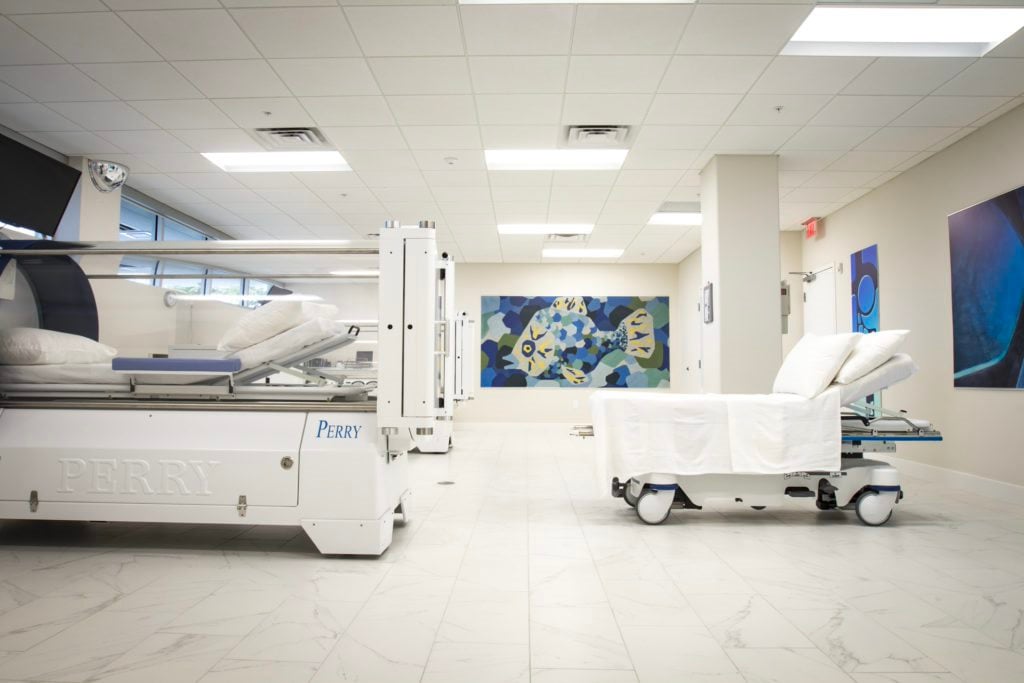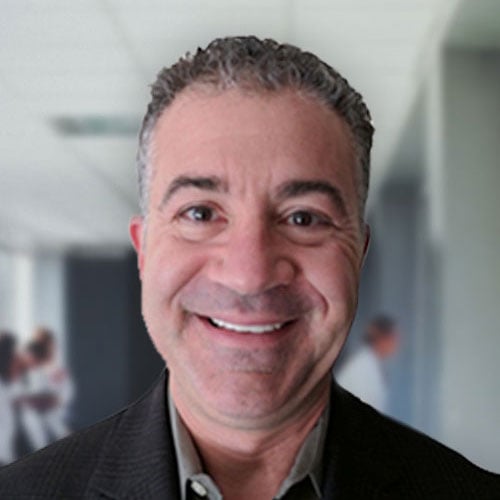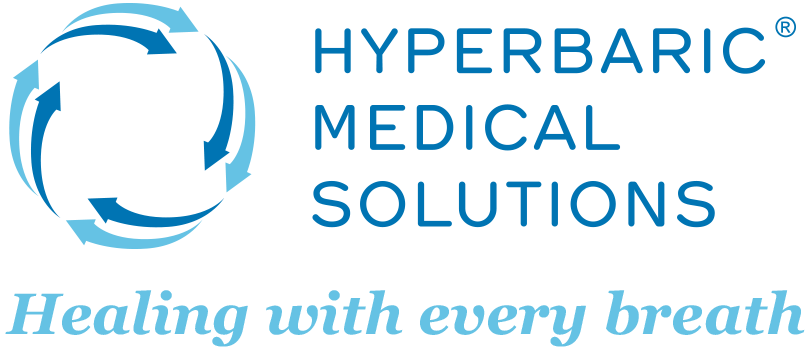How Does Hyperbaric Oxygen Therapy Help With Wound Healing?

THIS ARTICLE AT A GLANCE:
Hyperbaric oxygen therapy (HBOT) enhances wound healing by delivering 100% oxygen in a pressurized chamber, which increases oxygen levels in the blood plasma. This elevated oxygen supply promotes the growth of new blood vessels, reduces swelling, and boosts the immune system, thereby accelerating the healing process.
Hyperbaric oxygen therapy (HBOT) accelerates healing for various wound types via a chamber that delivers 100 percent medical grade oxygen, in a pressurized environment.
This process increases the amount of oxygen carried by the blood, stimulating the growth of new blood vessels, reducing swelling, and providing an overall immune system boost.
How Does HBOT Support Wound Healing?
Hyperbaric oxygen therapy (HBOT) helps wounds heal in several ways, all stemming from its ability to increase the amount of oxygen delivered to tissues.
1. Increased Oxygen Delivery:
- During HBOT, pure oxygen is breathed in, in a pressurized chamber, which dissolves more oxygen into the blood plasma. This increases the amount of oxygen delivered to all tissues, including the wound site.
- Wounds often suffer from oxygen deprivation due to damaged blood vessels or swelling. This lack of oxygen impairs healing and can lead to tissue death.
2. Improved Blood Flow and Reduced Swelling:
- The increased pressure in the chamber can also help reduce swelling around the wound, further improving blood flow and oxygen delivery.
- Better blood flow brings essential nutrients and white blood cells to the wound, aiding in healing and fighting infection.
3. Enhanced Growth Factors and Collagen Production:
- HBOT stimulates the release of growth factors, which are chemical messengers that promote cell growth and tissue repair. This helps the body generate new skin cells and blood vessels, crucial for wound closure.
- Additionally, HBOT encourages the production of collagen, a protein essential for building strong, healthy tissue.
4. Antibacterial Effects:
- The high oxygen levels in HBOT can create an environment less hospitable for certain bacteria, potentially aiding in infection control and promoting healing.
Overall, HBOT creates a more favorable environment for wound healing by:
- Boosting oxygen delivery
- Improving blood flow
- Stimulating growth factors and collagen production
- Reducing infection
Angiogenesis & Wound Healing
Hear our National Medical Director, Dr. Alan Katz, explain the process of angiogenesis to help heal wounds.
Who Is a Good Candidate for HBOT for Wound Healing?
Candidates for HBOT for wound healing may include the following:
- Individuals with wounds that haven't healed properly
- Patients looking to enhance their healing process
- Those with compromised skin grafts and flaps
- Diabetic patients with lower extremity wounds (diabetic foot ulcers)
- Individuals with radiation tissue damage
- Patients suffering from necrotizing soft tissue infections
- Individuals with non-healing wounds such as diabetic foot ulcers
- Those with thermal burns
- Patients who have recently undergone surgery
Wounds HBOT Can Help Treat
Compromised Skin Grafts & Flaps
Sometimes, skin grafts and flaps won’t adhere to the transplant site, meaning they’ve failed or been compromised. Hyperbaric oxygen therapy successfully treats these sites, creating healthy, oxygenated areas.
HBOT prepares the wound prior to the transplant and after, increasing the flow of blood and oxygen to the site, stimulating the production of collagen, regenerating damaged tissue, and reducing recovery time.
One successful study found HBOT improved the survival of the skin graft surface area by 29 percent, and all patients achieved more than 60 percent graft take.
Diabetic Foot Ulcer
Diabetes can lead to several complications, including diabetic foot ulcers. The American Podiatric Medical Association defines a diabetic foot ulcer as “an open sore or wound that occurs in approximately 15 percent of patients with diabetes and is commonly located on the bottom of the foot.” Six percent of those who develop these ulcers will be hospitalized.
Hyperbaric oxygen therapy successfully increases the rate of healing in diabetic foot ulcer cases and other diabetic lower extremity wounds. The pressurized oxygen decreases swelling, improves the body’s ability to fight infections, stimulates collagen production, enhances tissue cell growth, produces new blood vessels, and reduces amputation rates.
In addition to this treatment, patients must undergo wound debridement, take antibiotics, control their blood sugar, and use a special shoe or boot.
Gas Gangrene
Gas gangrene is a wound infection caused by the bacteria Clostridium, which forms gas under the skin, killing body tissue. This results in blisters, constant inflammation, and high fevers.
HBOT can reduce swelling, stop the bacteria and infection from spreading throughout the body, and minimize pain.
HBOT is a treatment option that repairs wounds, boosts blood flow, kills anaerobic bacteria, reduces the size of wounds, and diminishes the risk of amputation."
Necrotizing Soft Tissue Infections
Necrotizing soft tissue infections, which develop when various types of bacteria enter the body through a cut or scrape, are rare, yet severe. Once inside the body, the bacteria grows, releasing toxins that kill tissue. This can be deadly if caused by the bacteria Streptococcus pyogenes, which inhibits the body’s response.
Hyperbaric oxygen therapy can treat this difficult disease by blocking replication of certain bacteria, enhancing the body’s immune system, amplifying the effects of antibiotics, killing types of bacteria, and improving healing.
A study titled “Adjuvant hyperbaric oxygen therapy (HBO2) for treatment of necrotizing fasciitis reduces mortality and amputation rate” found HBOT reduced mortality from 34 to 11.9 percent, and morbidity from 50 to 0 percent.
Non-Healing Wounds
Approximately 6.5 million Americans experience chronic wounds, which can result from diabetes or obesity. Common non-healing wounds include diabetic foot ulcers, pressure ulcers, and venous stasis ulcers.
HBOT is a treatment option that repairs wounds, boosts blood flow, kills anaerobic bacteria, reduces the size of wounds, and diminishes the risk of amputation.
A systematic review of more than 620 studies concluded: “For patients with diabetic foot ulcers (DFU) complicated by surgical infection, HBOT reduces chance of amputation and improves chance of healing....There is a moderate level of evidence that HBOT promotes healing of arterial ulcers, calciphylactic and refractory vasculitic ulcers, as well as refractory osteomyelitis.” One study found that 28 out of 35 patients who underwent four weeks of HBOT demonstrated complete healing of nonhealing vasculitic ulcers, while four experienced partial healing.
Delayed Radiation Tissue Damage
Radiation, which can be used as a form of therapy for cancer, has the ability to destroy both healthy and cancerous cells, damage blood vessels, and cause chronic wounds. Delayed radiation tissue damage can present itself six months after treatment, making it difficult to diagnose and treat. This is where HBOT comes in.
Hyperbaric oxygen therapy can heal the damaged tissue by regenerating blood vessels, stimulating the production of stem cells, accelerating repair and recovery, and reducing inflammation and pain.
One study examined the use of HBOT in women who had received radiation after breast-conserving surgery. Of 44 patients with symptoms, 32 underwent 25 sessions of HBOT, while the remaining 12 received no treatment. “Patients [who were treated with HBOT] showed a significant reduction of pain, edema, and erythema scores as compared to untreated controls,” it concluded. Plus, seven of the 32 patients had no remaining symptoms after treatment.
Thermal Burns
A thermal burn is caused by an external heat source damaging the skin, and in some circumstances, the mouth, throat, and lungs. Prone to infection and inflammation, thermal burns may require surgical intervention.
HBOT can reduce pain and swelling, speed up recovery, and fight infection in such cases.
A study titled “Effects of hyperbaric oxygen therapy on experimental burn wound healing in rats: A randomized controlled study” found: “When used as an adjunct in a comprehensive program of care for severe burns, [HBOT] can significantly decrease mortality, lessen the need for surgery, and reduce length of hospital stay.”
Read our recent Case Study: Overcoming Severe Burns, Neuropathy & Memory Challenges with HBOT.
HBOT Under Medical Supervision
At Hyperbaric Medical Solutions, safety is our highest priority. To that end, every patient at our clinics is seen and cleared by a certified hyperbaric professional to ensure all potential contraindications are addressed prior to going into a hyperbaric chamber.
Additionally, all patient treatment plans are individually prepared by a hyperbaric board-certified physician, and each session is closely supervised by hyperbaric certified medical staff and trained technicians.
To ensure your safety, we strongly urge that you receive hyperbaric oxygen therapy under strict medical supervision.

Written by Alan Katz, MD, FUHM, FACEP, FAAEM
Dr. Alan Katz, National Medical Director of Hyperbaric Medical Solutions (HMS), is double board certified in Emergency Medicine and Hyperbaric Medicine. He directs clinical operations, as well as education and research initiatives for HMS, particularly in exploring the use of hyperbaric oxygen therapy....
Read More


